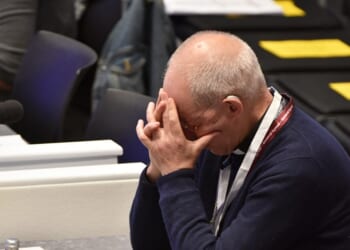TWO programmes about Wales, art, and love offered some welcome respite in a week otherwise dominated by noisy discussion about speech and its consequences.
Artwork: Love’s Moment: R. S. Thomas and Mildred Eldridge (Radio 4, Tuesday) considered the relationship between the Welsh priest-poet and his wife, the artist Mildred (Elsie) Eldridge, and the effect that each had on the other’s work. Elsie had already established a reputation as a painter by the time she met R. S: she had won the Prix de Rome prize, and a successful solo exhibition in London meant that she could afford to buy herself a Bentley.
Recognition for R. S. Thomas came after their marriage, with the publication, in 1946, of The Stones of the Field, a collection of poems so different from his earlier work that scholars suggest that it can be explained only by Elsie’s presence in his life.
“RS and I were on the moor . . . when we decided we could live together,” she wrote in her unpublished journal. Such stark pragmatism seems to have characterised their relationship. Their son, Gwydion, who died in 2016, said that they never expressed any affection. “They were like the ice king and ice maiden, but not unfond of each other.”
In 1954, the couple moved to the parish of Eglwys Fach. Elsie hadn’t wanted to move. Locals say that she was lonely, and they rarely saw her. That she bore most of the responsibility for, and the cost of, the marriage was acknowledged by R. S. in his poem “The Way of It”: “She is at work Always, mending the garment Of our marriage. . . If there are thorns in my life it is her who will press her breast to them and sing.”
As time went on, R. S.’s career eclipsed hers. She always made a living from her art, but it shrank — literally -— from large paintings to small watercolours. Her last large work was a 90-foot-long mural, The Dance of Life, completed in 1956. The presenter, Gwyneth Lewis, visited it with the art historian Peter Lord. They agree that it reveals “a crisis of identity”.
In “A Marriage”, R. S. writes of their meeting: “She was young . . . I kissed with my eyes Closed and opened Them on her wrinkles.” He said that he wasn’t a very loving person, but his poetry suggests otherwise. It is hard to imagine that he wrote such tender words about Elsie without speaking them to her, too.
In the Studio: Jon Foreman: Art that goes out with the tide (World Service, Wednesday) features the presenter, Dualtagh Herr, accompanying the land artist Jon Foreman to work. The studio, in this instance, is a Pembrokeshire beach, and the artist’s materials are the stones that he finds there.
The sound of the sea provides a constant backdrop to the programme, as Foreman observes and chooses his materials, draws outlines in the sand with his finger, and places stones over them, always knowing that the elements will soon take away whatever he creates. His philosophy is to “appreciate an artwork’s beauty during its brief existence”.
It takes about six hours for the artwork to come together. Then there is a delicious crunching as the first wave of the incoming tide hits it, dislodging and scattering the stones. Foreman’s works have an afterlife, however, in the photos taken by the drone that he launches minutes before the works are lost to the sea. They are beautiful, and I am glad that they exist. Such work needs to be shared and celebrated.
Gerry Lynch is away.















